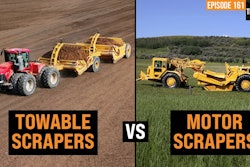Spring is here and that means it’s time to get your equipment prepared for the season.
But one fluid that’s often overlooked – to the potential detriment of your machinery – is the coolant.
On this episode of The Dirt, we hear from Shelly Eckert, business consultant with Chevron Lubricants, who explains the ins and outs of coolant maintenance, how to do it and why it’s so important.
She notes that 40% of engine failures are due to coolant issues. Yet often the attitude of operators is “top it up and go.”
Cooling systems and coolants have changed a lot since the ’90s. Today’s diesel engines have exhaust gas recirculation (EGR) systems to reduce the amount of nitrous oxide emitted and meet emissions standards. If your coolant becomes contaminated, it can change in viscosity and crack the EGR system.
So, the coolant’s condition needs to be checked regularly. And now that spring is here, the time is right for giving attention to it – along with all your equipment’s fluids.
To find out more on what you need to do to get your equipment ready for spring, check out the latest edition of The Dirt.
Equipment World serves up weekly videos on the latest in construction equipment, work trucks and pickup trucks – everything contractors need to get their work done. Subscribe and visit us at equipmentworld.com!
In This Episode:
- 00:00 - Springtime Coolant Best Practices
- 00:28 - Why You Should Be Worried About Coolant?
- 01:50 - How Do You Know if There’s an Issue with Your Coolant?
- 02:59 - How to Test Your Coolant
- 04:23 - Can You Use Water as a Coolant?
- 05:04 - How Often Should You Test Coolant?
- 10:05 - How to Correct the pH of Your Coolant
- 11:54 - How Do I Learn More About Coolant Best Practices?
- 12:44 - How to Know What Coolant Your Machine Needs
- 15:14 - How Often Should You Do a Coolant Flush?
- 16:31 - More Resources & Final Thoughts
Bryan Furnace (00:00):
Today we're here to talk about one of the most largely ignored fluids in your machine. We're here to talk about your coolant system. Joining us today from Chevron is Shelly, who's going to break down some good coolant practices now that spring is in the air.
(00:28):
So starting just at the top, at a very high level, why do I need to worry about doing more to my coolant system than just top-offs? What am I worried about breaking down in that system?
Shelly Eckert (00:39):
Well, it's a misunderstood situation, right? So coolant leads to about 40% of the engine related failures. So coolant is pretty much really important.
Bryan Furnace (00:52):
Wow.
Shelly Eckert (00:54):
Yeah, right? Which is amazing because at the testing facility where they test oil, fuel, and coolant, only 10% of the samples that come through are coolant samples. So really it's basically in the field, and what we need to get to is testing the coolant in the field. But coolant has gotten complicated over the years. And so it's traditionally green coolant would be conventional, a purple coolant would be fully formulated, extended life coolant would be a reddish color. But there's been a rainbow coolant that been released.
(01:26):
So you can't decide what's going on with the coolant by just the color. Unless the coolant is brown, that's not a coolant color. Brown is usually you've got rust or you've got mixing of two different coolants, and you've got a problem. Right? Coolant maintenance is something that should be routinely done, but it has this top-up and let go attitude, and that's not correct.
Bryan Furnace (01:50):
Yeah. So I guess as an amateur who knows nothing about coolants and how they've changed over time, or even what I'm doing to diagnose my coolant system, when I pop the cap on my radiator, what am I looking for? How do I know if there's an issue that needs to be addressed?
Shelly Eckert (02:08):
The volume in the cooling system is going down. You have to check it because typically that's water boiling off. And if water is boiling off, that means something is leaking and it's not keeping a pressurized system. So if you don't have a pressure system to check it, the cooling system, you have to check all the hoses and clamps, the number one problem is the radiator cap. So if the radiator cap is not keeping its pressure, it can cause the water to boil off. And you can see some of that by looking at the streaming that goes outside of the radiator cap or you see the salt from the water coming out. Sometimes. Not always, but sometimes. That's a clear indication that you've got a problem going on.
(02:49):
Replacing a radiator cap, you could be replacing it with a faulty radiator cap. So you've just got to test it again, drive around, and then recheck the coolant system. But the number one tool to check the freeze point, which is your indicator whether or not you've got the proper balance between black hole and water is a refractometer.
Bryan Furnace (03:11):
Okay.
Shelly Eckert (03:13):
It's pretty simple. It's literally you just open up the shield. And to make sure it's reading correctly, you put water on there. Just check it with water, make sure that it is reading correctly. There's typically a bolt at the top knob here that you would adjust it with a little tiny screwdriver, which typically goes missing like mine does.
Bryan Furnace (03:38):
There you go.
Shelly Eckert (03:40):
But you can always replace it with going to a Walmart or wherever, and getting that same screwdriver that you use to adjust glasses would still fit into this.
Bryan Furnace (03:49):
Okay.
Shelly Eckert (03:50):
Right?
Bryan Furnace (03:50):
Perfect.
Shelly Eckert (03:51):
Inside of this eyepiece is a scale. So it will tell you where the water line is at. And then after you check it to make sure that it's accurately reading, then you put the coolant on there, the glycol-water mixture, and make sure that it's 35 degrees, plus or minus 5 degrees. That's what I like to use.
Bryan Furnace (04:10):
Okay.
Shelly Eckert (04:10):
Although it's depending on where you're at in the country, sometimes you want it to be lower up in Canada or Niagara Falls. Right?
Bryan Furnace (04:18):
Sure. Where it gets really cold.
Shelly Eckert (04:21):
Where it can get really cold. Exactly. Initially, cooling systems were actually just cooled with water. But because our temperatures fluctuate, glycol was introduced so it drew the coolant back down. Now, if you're in really warm temperatures like Hawaii or the Gulf of Mexico, you don't meet the glycol. You just use water.
Bryan Furnace (04:43):
Really? So even in this day and age, you're still using primarily water?
Shelly Eckert (04:47):
In the southern warm temperatures, you can't. You're stuck on the road, for example. All of a sudden you've blown a hose and you have no coolant, the best option is to just get water and put it in there.
Bryan Furnace (04:59):
Yeah, just as a temporary fix to get you back. Yep.
Shelly Eckert (05:03):
Mm-hmm.
Bryan Furnace (05:03):
So I guess another question is, traditionally in the field, you've kind of nailed it. We don't really look at our coolant system unless we know it's running low or the check engine light came on. That's when we're going to go look at the coolant system. What should we be doing? What should a regular coolant maintenance schedule look like? How many times a year should I be getting in there and taking a look at the coolant and addressing something?
Shelly Eckert (07:21):
What I direct my place to do is to check that coolant every time that truck's in the shop.
Bryan Furnace (07:26):
Okay.
Shelly Eckert (07:26):
It's so simple. You can use multiple tools that are available in the field, and when it gets really complicated, then you can send a sample into the lab. It's not just glycol, right? It's what's in the glycol, additives, and so forth, right? That helps protect the coolant system, the metallurgy. But in the field, you can use various tools, test strips, like pH test strips, right? pH is very important. So a pH can tell you if you've got an EGR leaking gas into the coolant system. It'll drop your coolant. What happens when the coolant goes up into the EGR? That's one of the hottest places on the truck. So if it causes the EGR to crack, that gas gets into the coolant, makes the coolant acidic. That's a bad thing.
Bryan Furnace (08:11):
Interesting.
Shelly Eckert (08:12):
Right? Well, things change. So I think before the EGR came on the market, there was a lot of us that were sitting there saying, "Well, go to extended life coolant, maybe shift the freeze point once or twice a year, but forget about it." Well, when the EGR came on the market, that should have all stopped.
Bryan Furnace (08:29):
So how many times a year would you consider appropriate for checking pH?
Shelly Eckert (08:34):
This is going to sound terrible to say, once or twice a year.
Bryan Furnace (08:36):
Okay.
Shelly Eckert (08:37):
As long as the freeze point's fine.
Bryan Furnace (08:40):
Sure.
Shelly Eckert (08:40):
But the way I do it with my fleets, I tell them to use both.
Bryan Furnace (08:45):
Yeah. So once or twice a year, maybe at the changing of the seasons, we need to go in. And it sounds like we need to, at least once a year, pull a sample and send it off to the lab just to get it tested. We need to do a pH strip and we need to do a refractometer test?
Shelly Eckert (09:01):
Bryan, I'm going to take that back a step. So the one thing that you can do is you can do all this in the shock. You can test the coolant, whereas if you take a coolant sample, you send it into the lab. With transit time and testing time, you're talking a week. The labs would probably smack me for saying this, but you can actually just do this in the field and this is so much less expensive to do it.
(09:24):
So the other things you can do for testing is there are nitrite test strips. Some of these OEMs do not want nitrites being used in the coolant system because it can cause problems such as the aluminum radiators will react with some of the nitrites and cause ammonia hydroxide, for example. And that'll react with steel and cause head gasket leaks, or it can cause the solder to break down and cause the radiators leak to fail. So there's a lot of reasons why to test the coolant because technology changes and old school is not always the best way to practice. Top it up and forget about it, that's just gone. That's gone these days.
Bryan Furnace (10:05):
Yeah. So let me ask you this. If I test my coolant and it turns out it is acidic or it's a little too basic, it's one side or the other, is that something... obviously if we have an EGR leak, that's got to be addressed. But then bringing that coolant back in line, is that something where I need to do a full coolant swap or is there something that I can do to either raise or lower the pH of that coolant?
Shelly Eckert (10:25):
That's a really good question. So let me start with the pH. If a pH is... I like to focus on an eight. So if it drops below an eight, gets into a seven or six, that means you're getting into more of acidic environment. With an extended life coolant, an eight is target. When you're looking at fully formulated or a conventional coolant, then you're talking about something that's going to be 10, 11 on the pH test strip.
(10:54):
So when you look at a pH and if the fleet is supposed to be using extended life coolant and it's going to a pH of 10 or 11, that typically means that a fully formulated or conventional coolant has been mixed. Or somebody's using something on a coolant additives that are usually used for fully formulated. Or old school, if you have an older truck, you might have a coolant filter that is pouring in additives, conventional additives, which will cause the pH to go up. So I used to tell my fleet instead, "Find the source and starve it, take it away, and then the pH will go down." Well, Detroit came out with a series bulletin that said if it's 10 and above, we want you to drop it, dump it, drain and flush it.
Bryan Furnace (11:40):
Yep.
Shelly Eckert (11:42):
Okay? So it depends. And really what you need to do is have somebody that understands coolant enough to do a conversation like you and I are having right now, educational system.
Bryan Furnace (11:54):
And where would I find someone? So if I'm a small business owner, got me and a couple of employees, I don't have a coolant specialist, where do I go find someone that I can kind of pick their brain on this?
Shelly Eckert (12:05):
Go to you.
Bryan Furnace (12:08):
Oh, I got a lot of education to get in before people start calling me.
Shelly Eckert (12:17):
I hate to say this, but there's so much on YouTube that you can find anything.
Bryan Furnace (12:23):
Yeah. So YouTube would be a great resource for someone who might need a little more information in this area.
Shelly Eckert (12:28):
Yes. And you want to look at different resources because not everybody out there knows what they're talking about. So if you use different resources, then you can collaborate. Or you can contact the local dealer and ask them questions.
Bryan Furnace (12:44):
So my final question for you is, when I go to replace my coolant as, again, someone who is totally ignorant on coolants, am I just picking a color? How do I know what color to pick? What do I need to put back in my machine? How do I know if I need an extended life or if a regular coolant?
Shelly Eckert (13:03):
First of all, there's typically a decal that'll tell you what was originally put into the truck. Or not just truck, but you know what I mean. Sometimes that changes depending on your preference, right? But what's factory fill is typically what the OEM wants to be using. But the color of the coolant, it just means nothing. I've run into coolant that is green, but it's a Japanese hybrid coolant. It's not a conventional coolant.
Bryan Furnace (13:33):
So if I understand, throw color out the window. If you ever thought you're matching colors when it comes to coolant, that is the wrong approach. You need to actually look at what's going on on the box, you need to look at what's going on on the sticker on the equipment, and you need to match accordingly.
Shelly Eckert (13:48):
That's correct. That doesn't mean the brand, that just means the type.
Bryan Furnace (13:52):
And we've covered in previous videos, it is a huge no-no to mix coolant types because you can actually cause some really bad things to happen inside the coolant system. Correct?
Shelly Eckert (14:02):
Absolutely. You can mix up to 25%. But by the time you're at 25%, the color could be so different that you can't tell. You would send it into the lab or you just drain it and put in the coolant you should be using. Sometimes what'll happen when you mix the two different coolant types together, you can have the additives fight with each other and cause additive dropout. And there's no other way I can get around this. It's called white flocculant. It's no different than when you take salt and you pour it into water, you get to a point where there's too much salt that it doesn't melt and it starts to accumulate. That's white flocculant, same thing.
Bryan Furnace (14:40):
But those are your additives, the things that are supposed to be helping your coolant system that are now dropping out. And I'm assuming because you now have solids in the coolant system, now you're getting clogging issues and all sorts of other badness happening.
Shelly Eckert (14:51):
Yep. Bad, bad, bad.
Bryan Furnace (14:52):
I think this is a good beginner step into getting into coolants. So just to recap, test strips and your refractometer, we're going to use at least twice a year. Generally good timing is when the seasons are changing anyway because you need to kind of just check out the coolant system.
Shelly Eckert (15:09):
In my opinion, when you're changing the oil, you should be checking the coolant system at the same time.
Bryan Furnace (15:14):
Okay. Every handful of years should we do a coolant flush, or is that mostly based more on the results that you're getting from your test strips and your refractometer?
Shelly Eckert (15:24):
Bryan, that's a great question. It depends on the guidance of which coolant you're using. Because there are coolants that are defined as long life, and then there's coolants that are conventional or conventional long life, extended life coolant. You have to look at the fine print of that coolant to determine how long you can run that coolant.
Bryan Furnace (15:42):
Okay.
Shelly Eckert (15:44):
Right? But testing it is important. Because if you have a coolant that's using a million miles or 12,000 hours, but you have been topping it up because you've blown a hose or you've got to lose clamp or the radiator cap is not keeping the pressure on the cooling system, you're essentially sweetening the coolant, which goes back to testing it versus changing it at a set time. So you start with what you're buying and what you're putting into the cooling system as to longevity of that coolant. But you really definitely need to test it. Like I said, you don't need to send it into the lab unless it's really a big, big problem and you can't figure it out by looking at basic tools, then send it into the lab.
Bryan Furnace (16:30):
Yeah. And just to restate, obviously screen multiple sources, but YouTube is a great resource for getting a handle on what your base pH you're working off of should be, depending on your particular type of coolant, what those test strips should look like when they're testing appropriately. YouTube is the resource there that you would recommend.
Shelly Eckert (16:52):
There's always training modules that are from the OEMs that would be available.
Bryan Furnace (16:59):
Okay.
Shelly Eckert (17:00):
Right. Caterpillar has some guidance. John Deere's got guidance. Komatsu's got guidance. It's all out there.
Bryan Furnace (17:07):
Perfect. Well, Shelly, thank you so much for all the information. It's such a largely ignored system, and I'm so ignorant on it. So it's nice to get a little guidance here. And I'll have to go do a little more research before people start blowing me up because you just gave my number out. Well, thank you so much for the time. We really appreciate it.
(17:26):
Well, thank you again for Shelly being willing to come on the show and discuss coolants with us. This hopefully gives you a little insight as to what you can do to properly maintain your equipment now that the seasons are changing.










